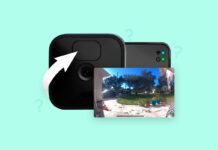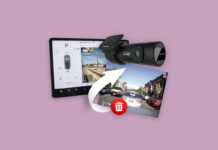 Need to recover deleted photos? While the process is generally easy, it can get confusing because it varies depending on the device you’re using. So we decided to create an all-in-one guide specifically for photo recovery so you can find all the information you need in one place.
Need to recover deleted photos? While the process is generally easy, it can get confusing because it varies depending on the device you’re using. So we decided to create an all-in-one guide specifically for photo recovery so you can find all the information you need in one place.
Photos are usually stored in cameras, smartphones, and SD cards – for many people, they’re spread out among all three. So in this article, we’ll cover them all: how to recover deleted photos from SD cards, cameras, and phones, using Mac, Windows, iOS, and Android. Read on!
Table of Contents
How to Recover Deleted Photos from Camera SD Card
A big chunk of our readers are photographers – can you guess why? SD cards are commonly used for modern cameras, where they store precious high-resolution photos and videos. However, we tend to handle camera SD cards more often because we constantly transfer data between devices (for ex. camera to PC). This leads to more opportunities for data loss.
Below, we’ve prepared 3 methods to recover deleted photos from your SD card. While the following sections focus more on camera SD cards, they serve as appropriate guides for general SD card recovery and even external hard drive recovery (another common storage device for photos).
Method 1: Check Trash Bin on Mac or External Device
Did you notice that the photos on your camera have gone missing after attempting to transfer data to your computer? You may have accidentally deleted your photos while your SD card was connected.
Fortunately, deleted files usually stay in the system’s Trash folder until the user manually empties it. And you might not know this, but some storage devices like SD cards and external hard drives have their own Trash folder (.Trashes) as well. We’ll show you how to access both.
To recover deleted photos from Trash on a Mac:
- Open the Trash folder from your dock.
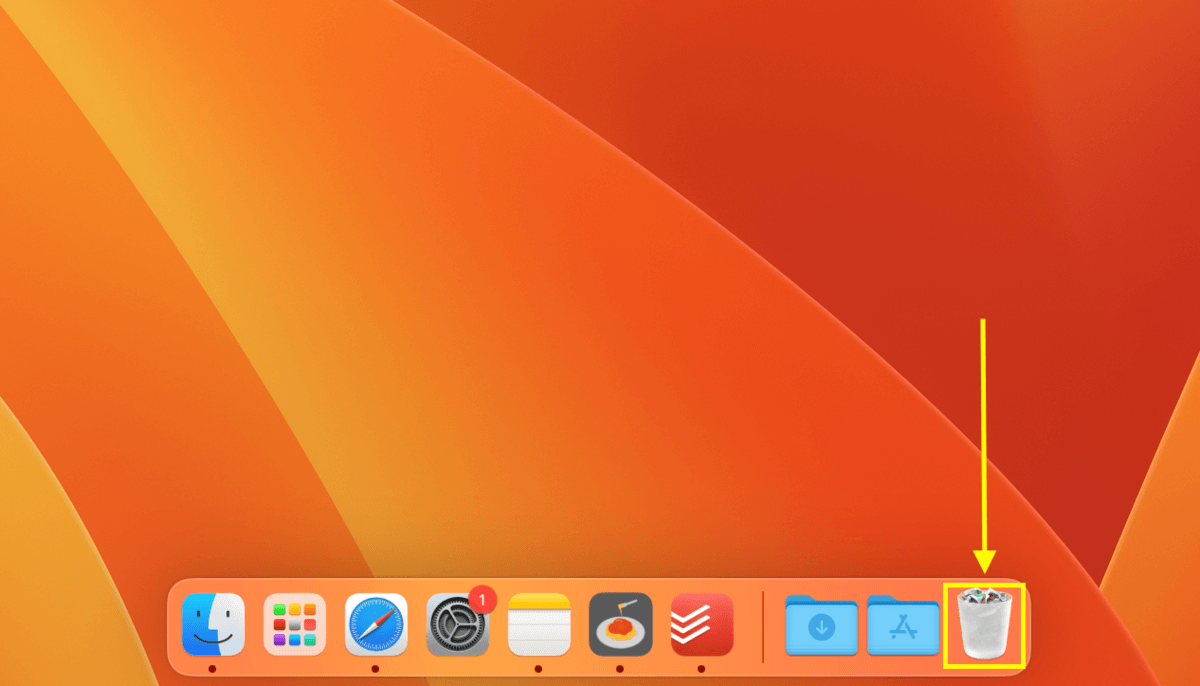
- Right-click the photo (or multi-select > right-click if multiple) and click Put Back. You will find your photos in their original folder.

The instructions for Windows PC are pretty much the same. However, you’ll be looking for the Recycle Bin instead of the Trash folder.
To get deleted photos back from the Trash folder on an external storage device:
- Open your SD card’s root folder in Finder.
- Hit the CMD + Shift + > keys to show hidden files and double-click the .Trashes folder.
- Copy and paste the photos to another location.
For Windows computers, open your SD card’s root folder in Explorer and click View and enable Hidden Items in the Show/Hide menu.
Method 2: Recover Deleted Photos Using Data Recovery Software
If you lost your photos while your SD card was still in your camera, you won’t be able to access them through your computer’s operating system as you normally would. Recovering permanently deleted photos is only possible with data recovery software – it can access the file system of your SD card directly and restore the deleted photos using advanced algorithms.
We’ll be demonstrating this process using a tool called Disk Drill. It’s a popular data recovery software that supports a massive number of image file types – including common ones like JPG and PNG, as well as RAW file types like CR2, GPR, and NEF (among many others).
How to Recover Deleted Photos Using Disk Drill for Mac
To recover permanently deleted photos from SD card using Disk Drill on Mac:
- Download and install Disk Drill.
- Remove your SD card from your camera and connect it to your Mac using a card reader or adapter. Then, launch Disk Drill (Finder > Applications).

- Select your SD card and click Search for lost data. If you’re using a USB card reader, it may appear as “Generic Storage Device.”
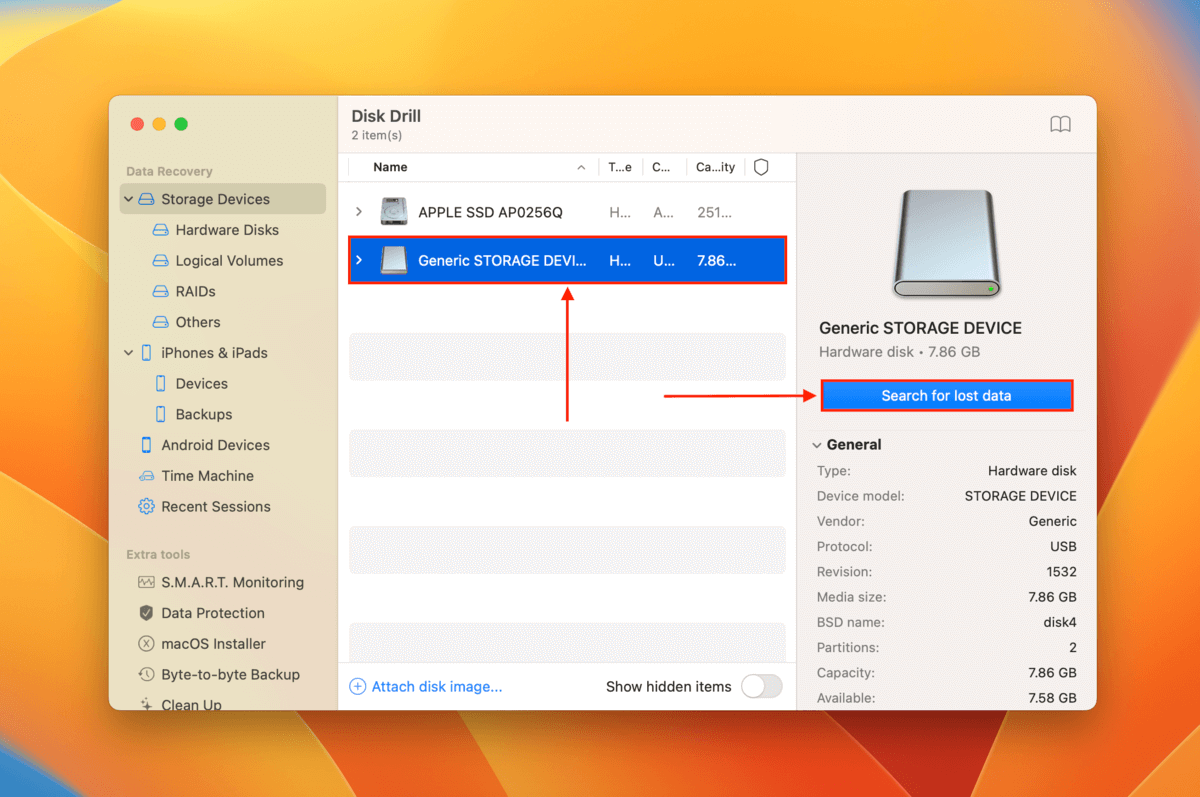
- Wait for Disk Drill to finish scanning your memory card. Then, click Review found items.
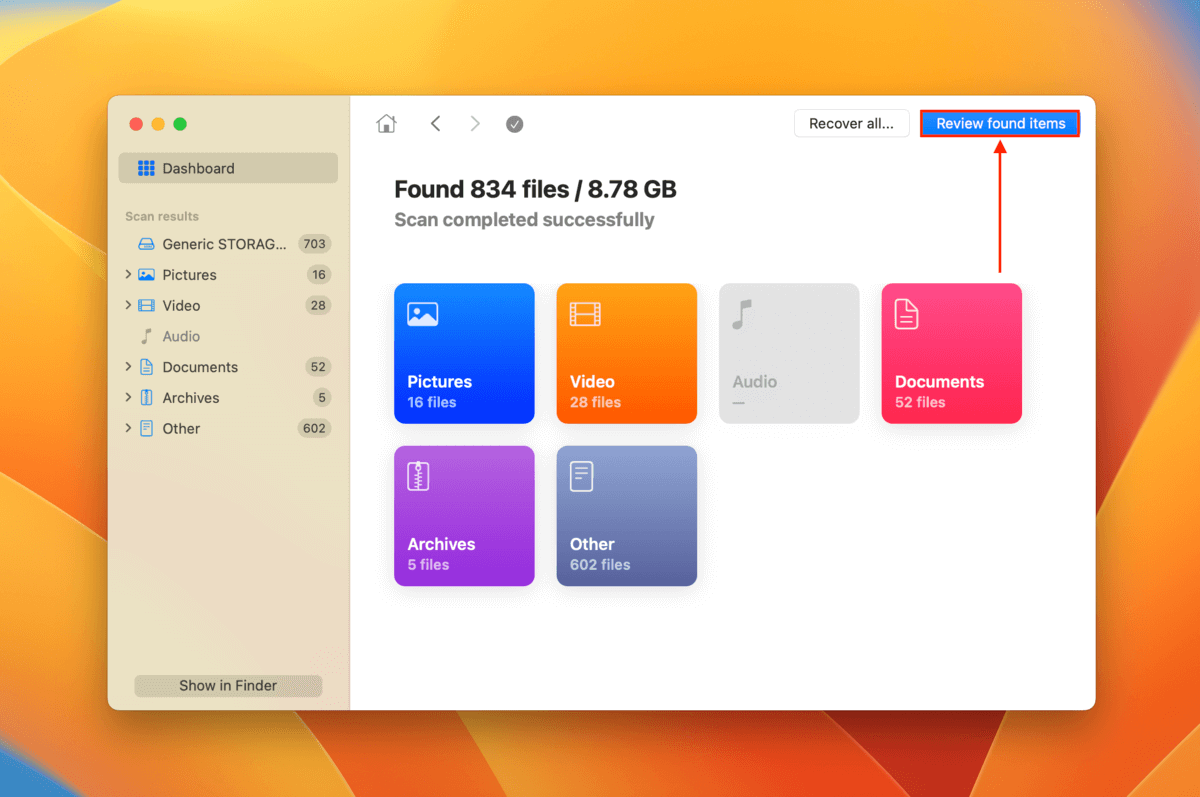
- Select Pictures in the left sidebar and filter the data by file extensions using the search tool in the top-right corner of the window. Then, open the Deleted or lost tab and locate your photos. If you hover your mouse pointer beside them, an eye button will appear that, when clicked, will display a preview of your photo.
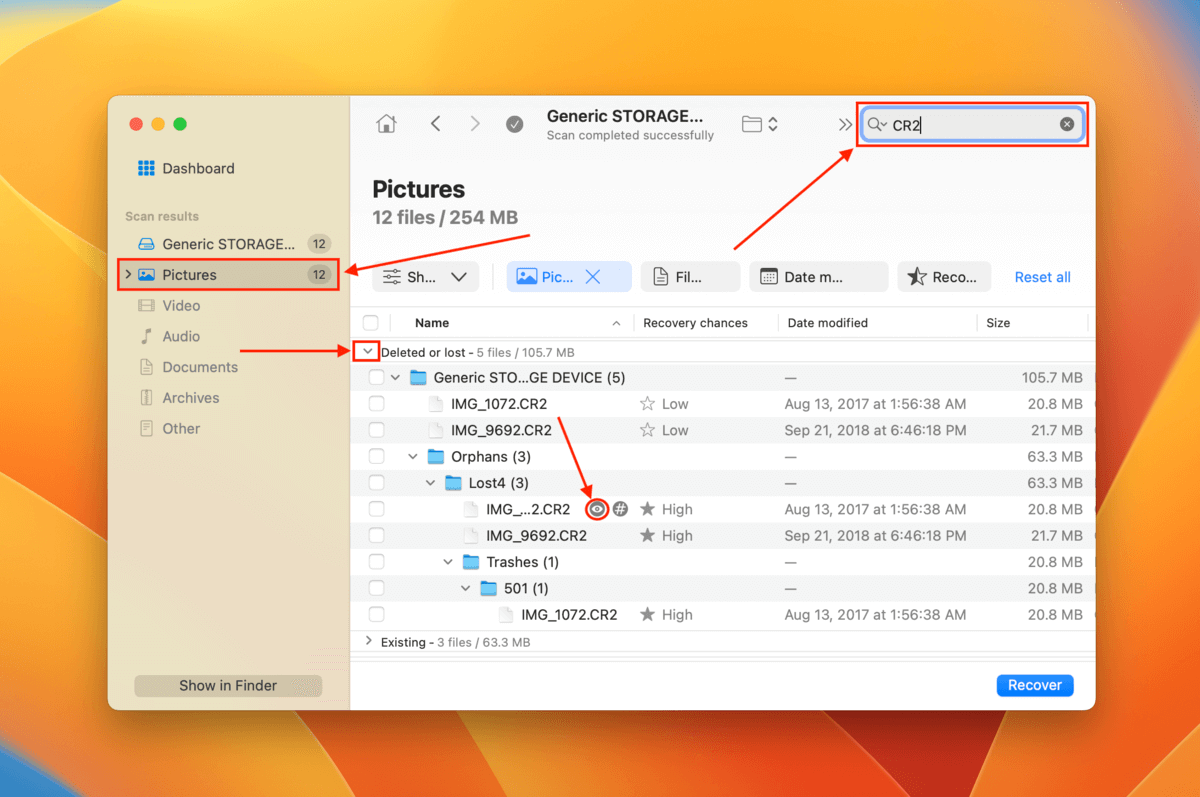
- Use the boxes in the leftmost column to select the photos you want to restore. Then, click Recover.
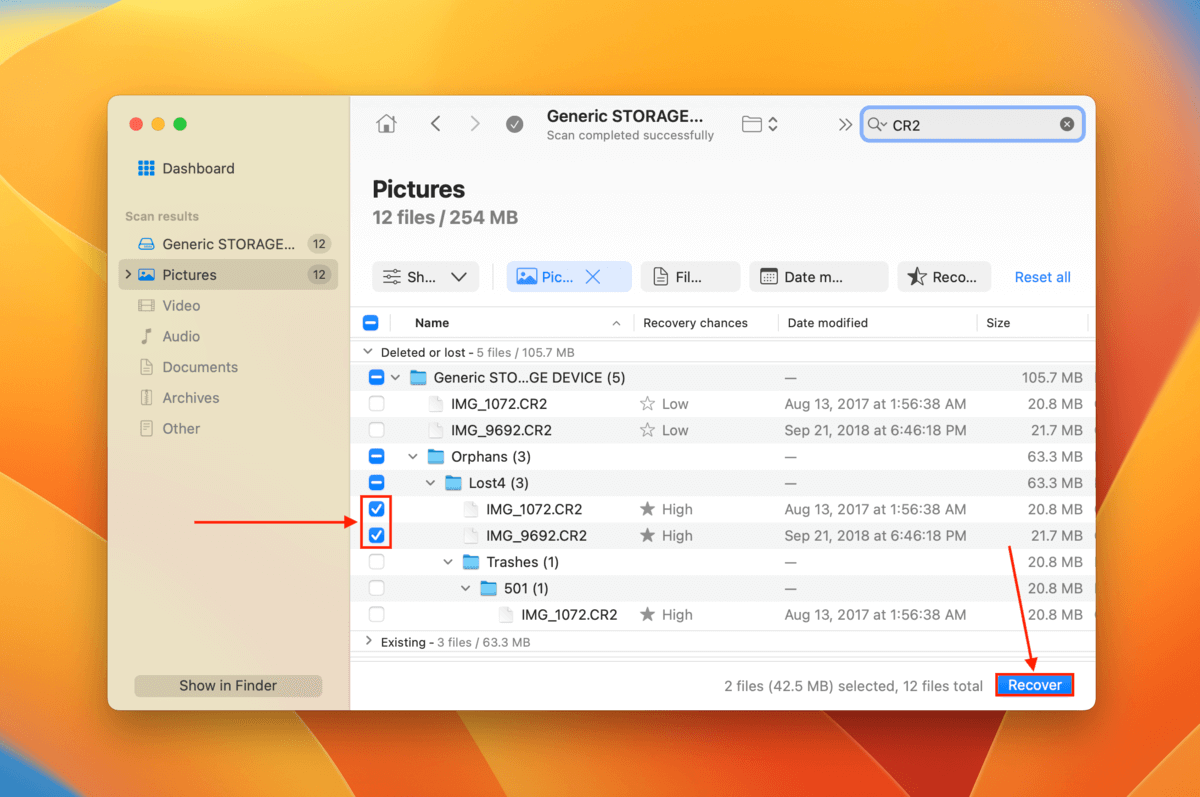
- Select a location on your computer where Disk Drill will save the recovered files. Then, click Next.

How to Recover Deleted Photos Using Disk Drill for Windows
To retrieve deleted photos using Disk Drill on Windows:
- Download and install Disk Drill.
- Remove your SD card from your camera and connect it to your PC. Then, launch Disk Drill.

- Select your memory card from the drive list and click Search for lost data.
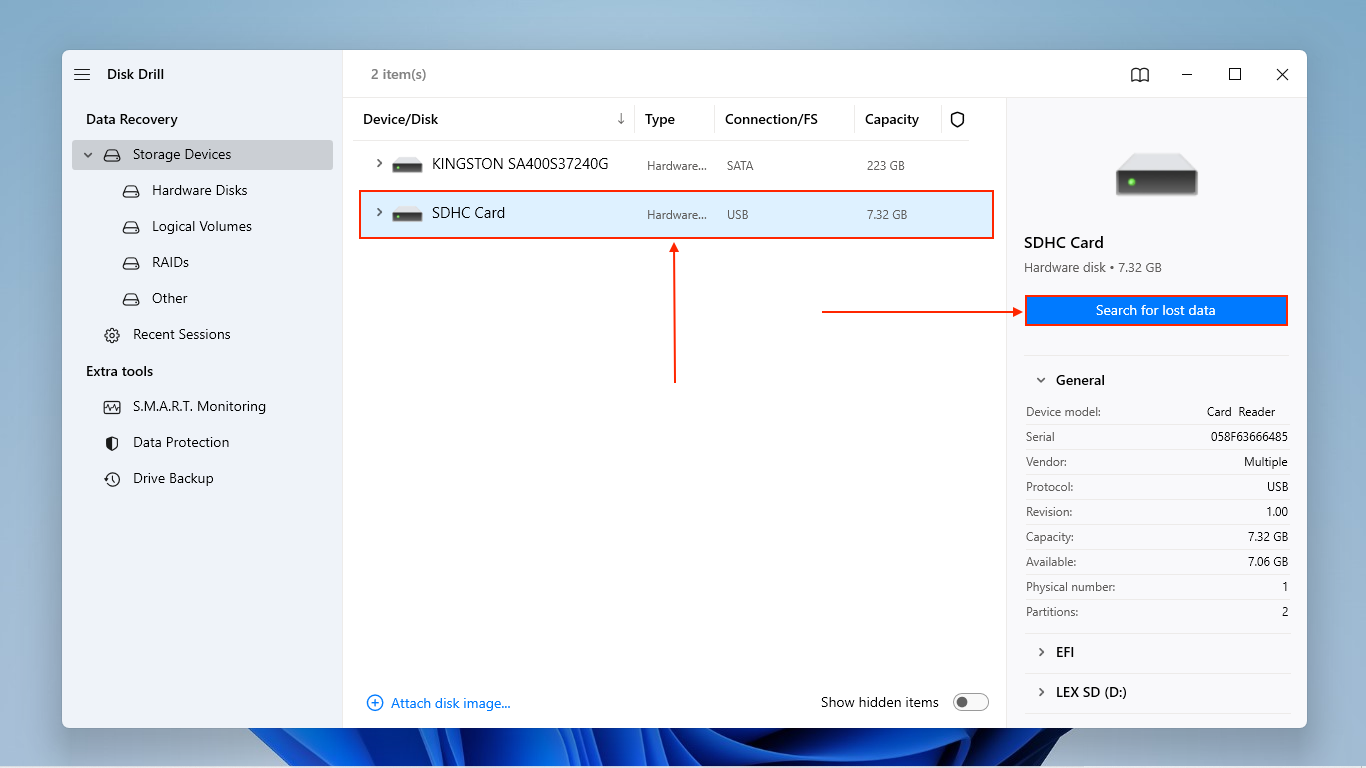
- Once Disk Drill completes the scan, click Review found items.

- Select Pictures in the left sidebar. Then, use the search tool in the top right corner of the window to filter the scan results by file extension. Expand the Deleted or lost tab and locate your photos. Clicking on any file once will display its preview in the right pane.
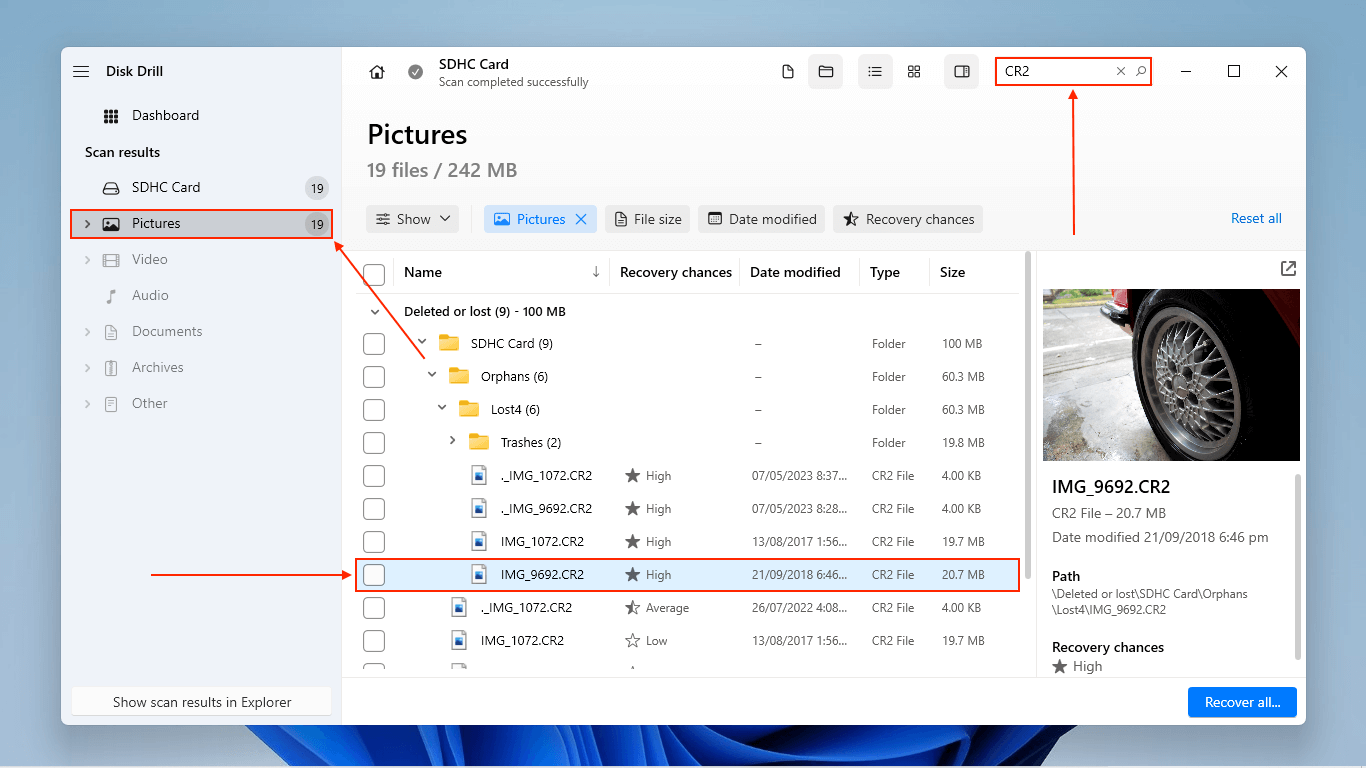
- Tick the boxes beside the photos you want to restore. Then, click Recover.
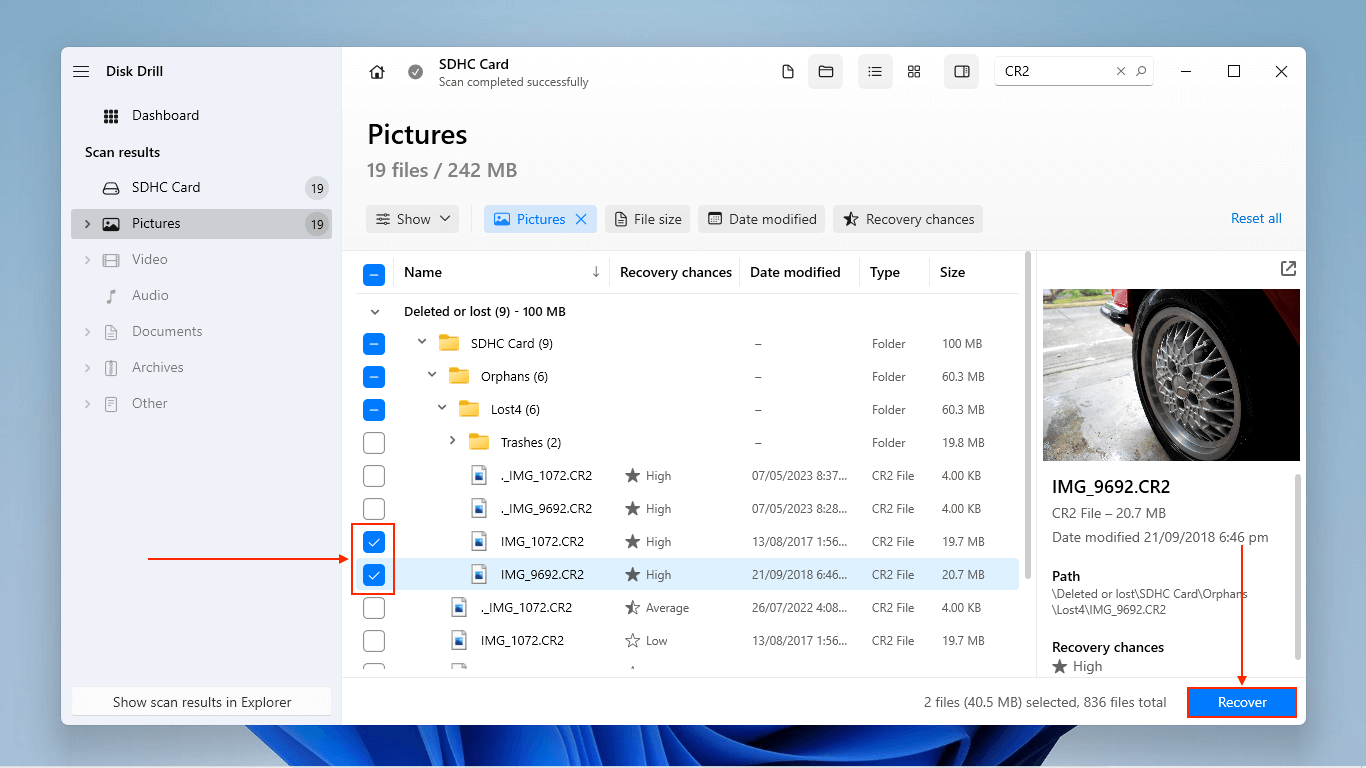
- Select a location on your PC where Disk Drill will save your recovered photos. Then, click Next.
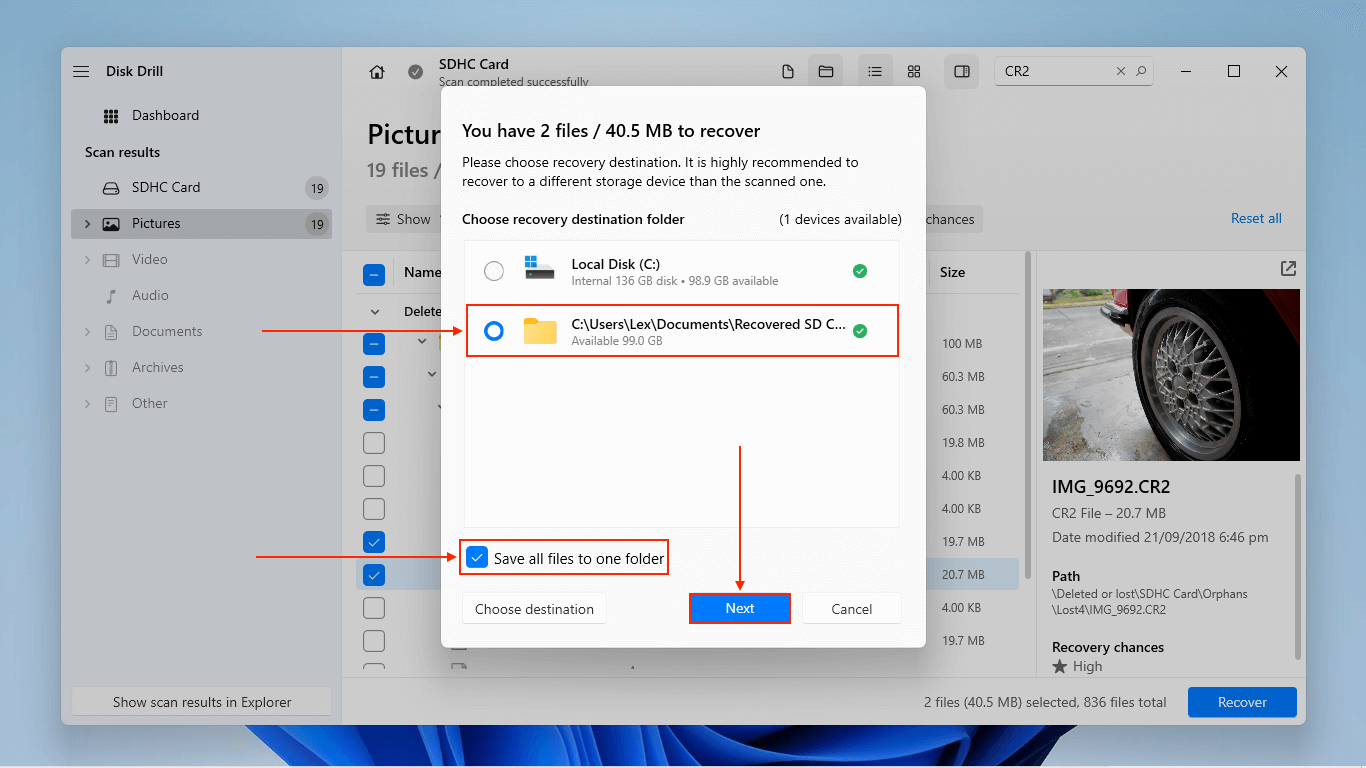
Only the Windows version of Disk Drill Basic offers free data recovery (up to 500 MB). However, you can scan and preview data as much as you want on both Mac and Windows. This is useful for determining whether your data is recoverable.
Method 3: Send Your SD Card to a Data Recovery Service
If you think the data loss was a result of physical damage, we highly suggest that you send your SD card to a professional data recovery service. Retrieving deleted photos yourself from a damaged storage device may lead to permanent data loss.
A professional data recovery service consists of specialists that are trained to physically take apart storage devices and perform more advanced data recovery operations. They also have special tools and facilities to protect the technology.
Here are some tips for selecting the right service:
- Clean Room – Make sure the shop uses a Class 100 Clean Room. This protects the storage devices from further damage caused by particles and debris.
- No data, no charge – Some shops will only charge you if they recover the data you were specifically looking for.
- Free phone estimate – Experienced data recovery specialists should be able to give you a rough estimate over the phone – this is also an indication that they are confident in their pricing.
- Good reviews – Most major data recovery services have reviews on Google and websites like Trustpilot. Find as much information as you can (don’t hesitate to call them) to properly weigh your options.
How to Retrieve Photos Deleted from an iPhone
If you deleted photos directly from your iPhone, you can use different devices to employ a variety of data recovery methods. In the sections below, we’ll demonstrate 7 iPhone recovery methods that you can try yourself.
Method 1: Check the Recently Deleted Folder in the Files App
If you deleted your photos from the Files app, they would have been moved to the Recently Deleted folder for 30 days before actually getting erased. As long as 30 days haven’t passed yet, we can restore files from the Recently Deleted folder and return them to their original folder.
This location is different from the Recently Deleted folder of the Photos app. If you deleted your photos from the Photos app and not the Files app, skip to Method 2.
To find recently deleted photos in the Files app (and restore them):
- Open the Files app.
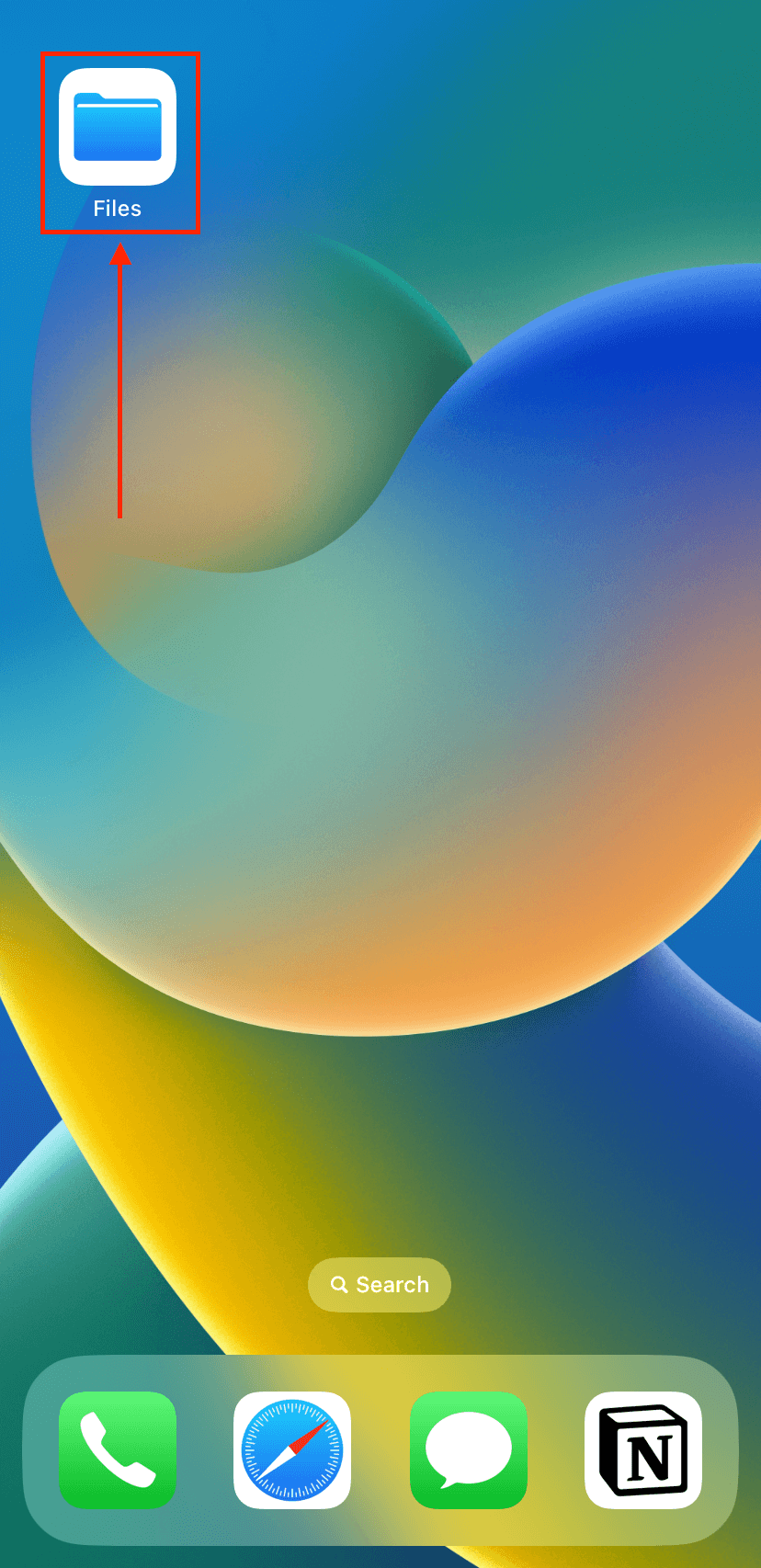
- Tap Browse at the bottom of the screen. Then, tap Recently Deleted.
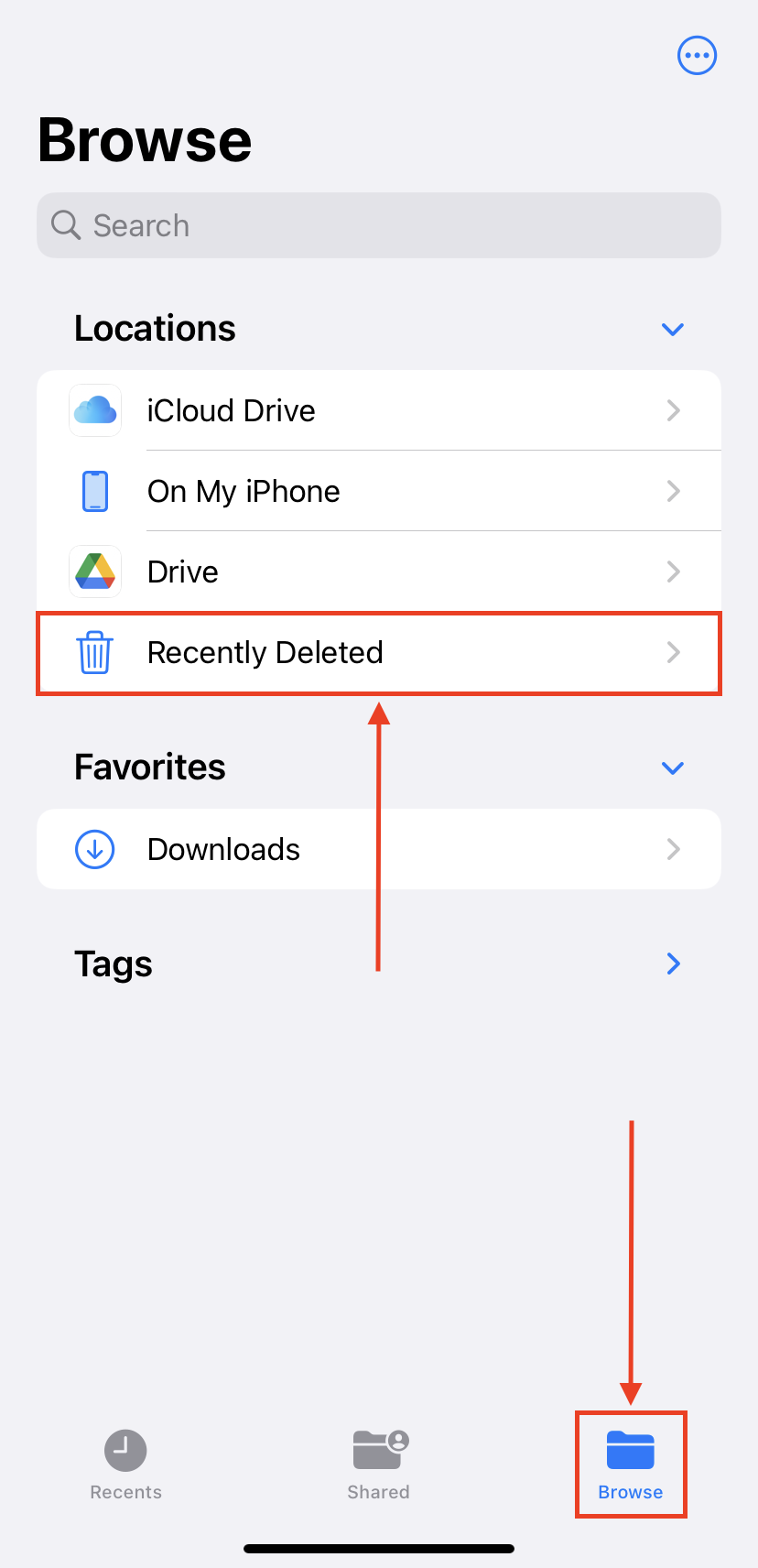
- Tap and hold the photo you want to restore and tap Recover. It should reappear in its original location.
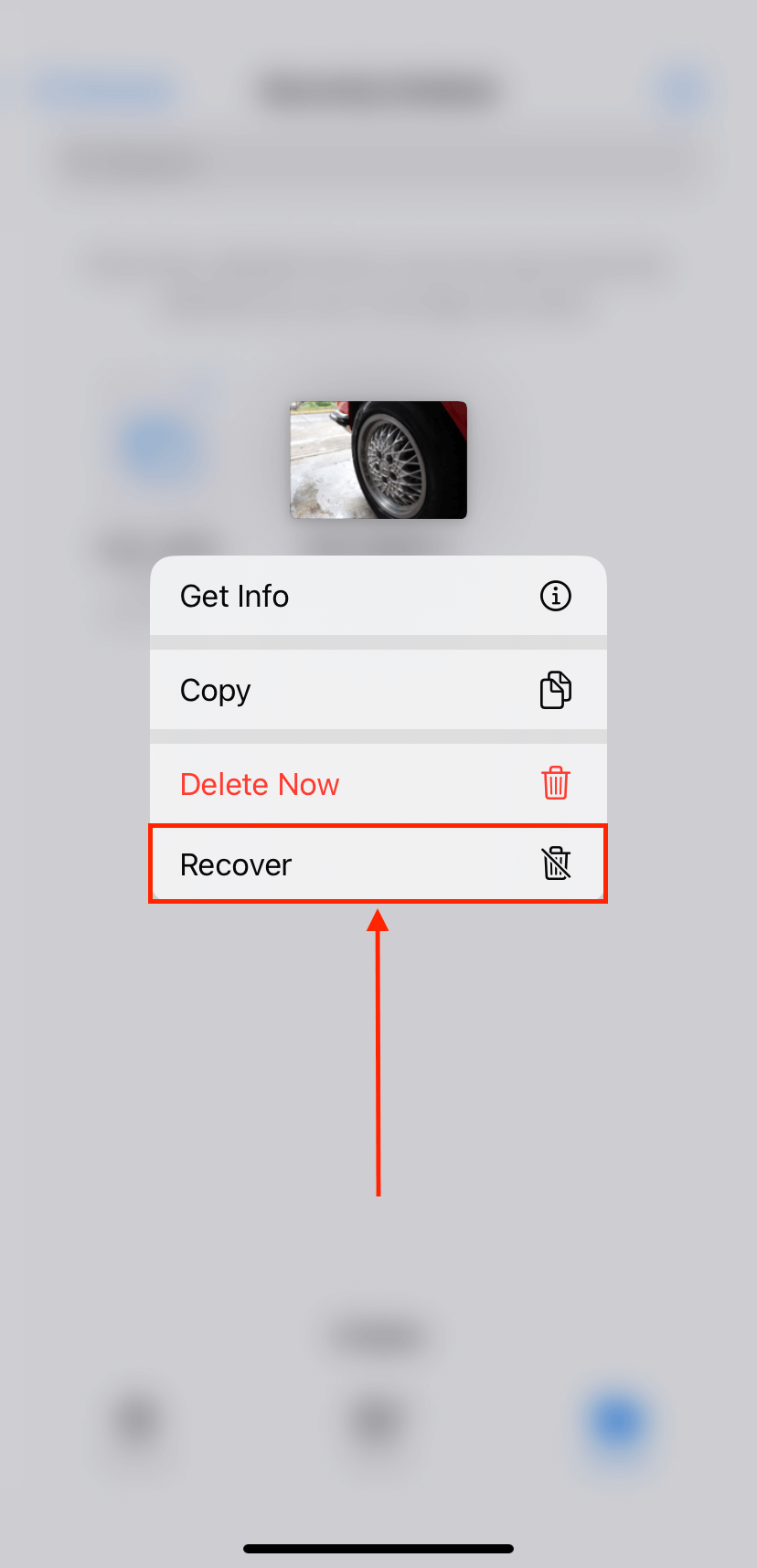
Method 2: Check the Recently Deleted Folder in the Photos App
When you delete photos from the Photos app, they are moved to the Recently Deleted folder also within the Photos app. You can check your recently deleted photos for 30 days, after which they are permanently deleted.
How to retrieve deleted photos from the Recently Deleted folder in the Photos app:
- Open the Photos app.
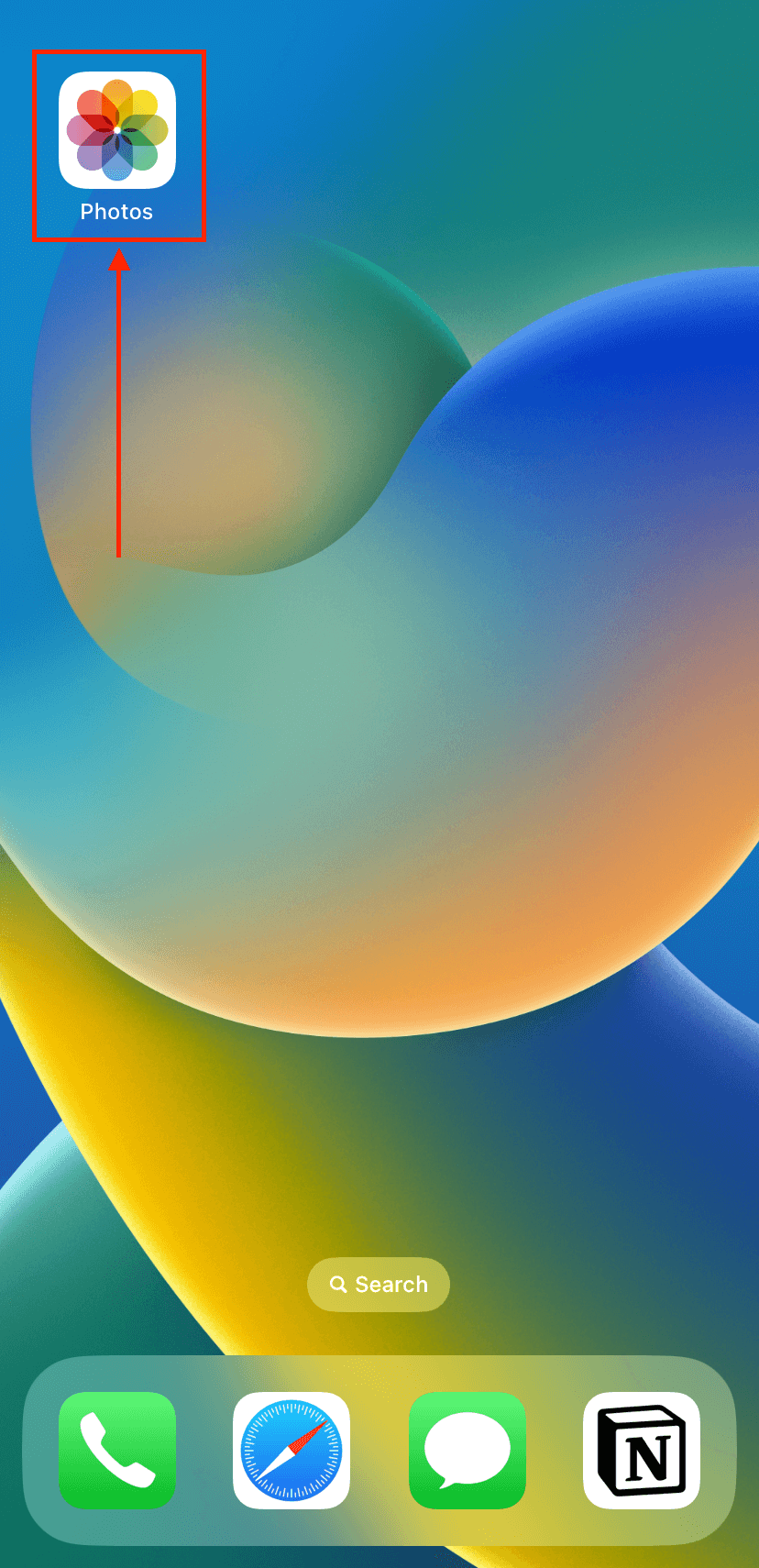
- Tap Recently Deleted (you may have to scroll a bit) and input your Face ID, Touch ID, or PIN when prompted.
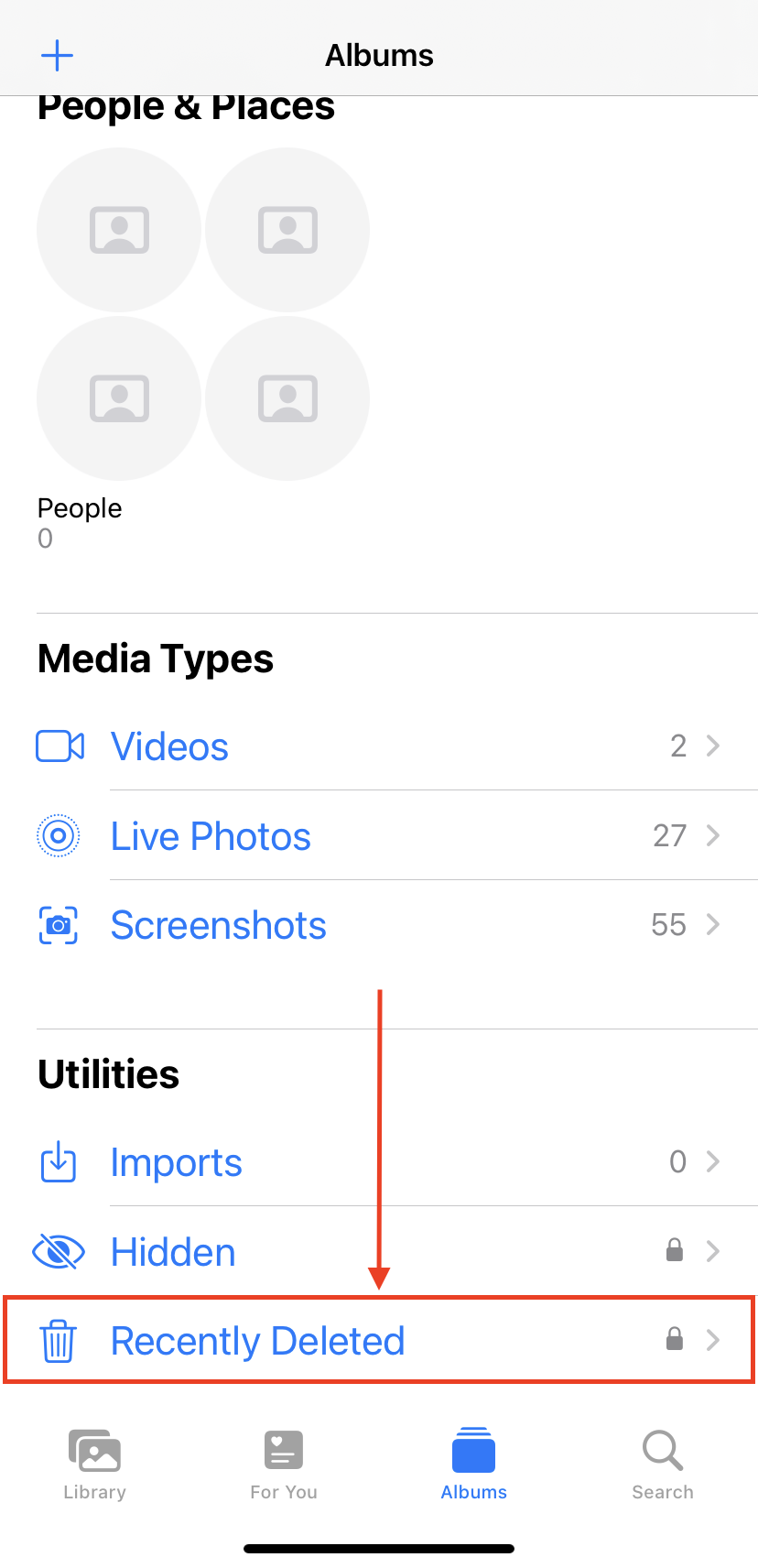
- Tap on the photo you want to restore and tap Recover. You can also tap the Select button to select multiple photos at once.
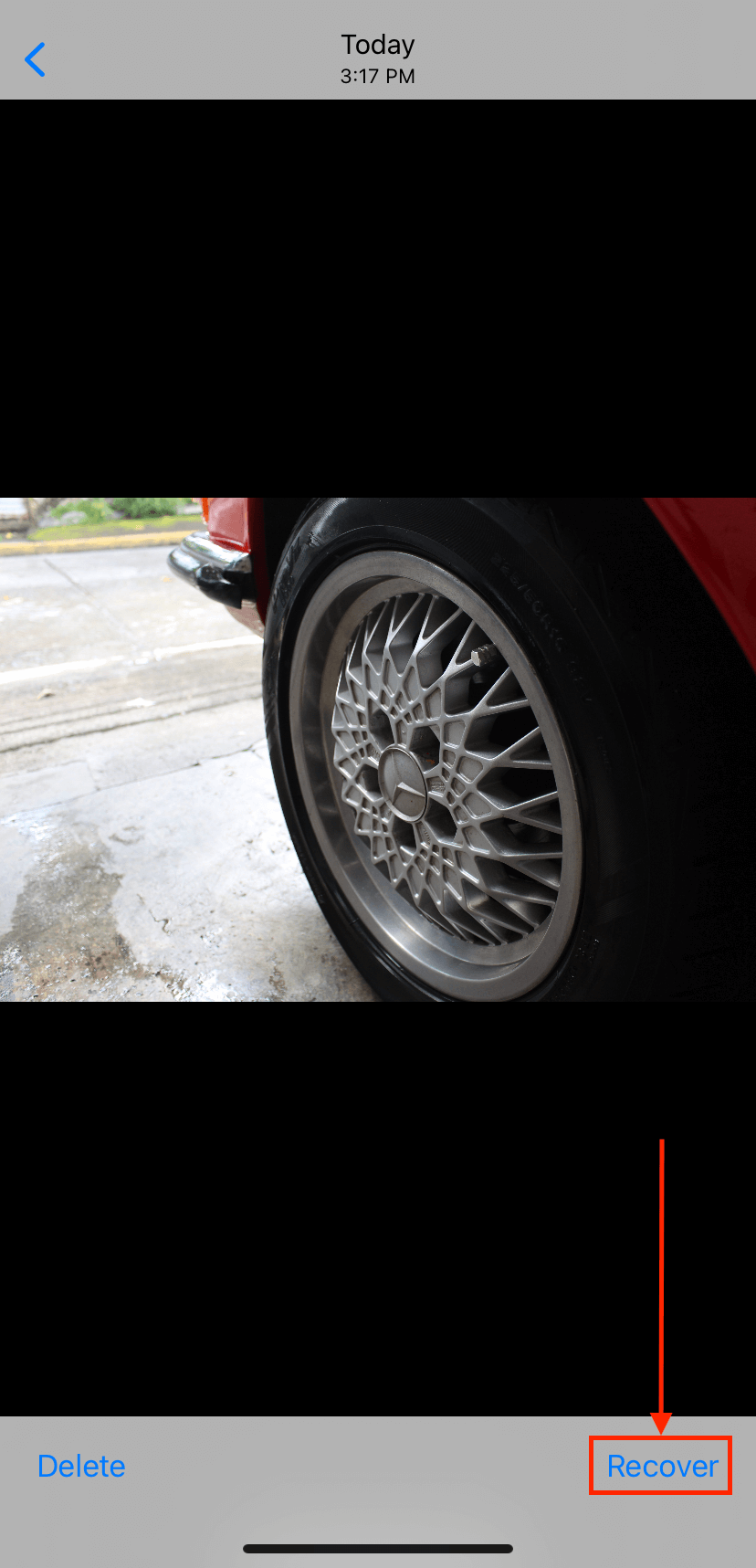
- Tap Recover Photo to confirm the action.
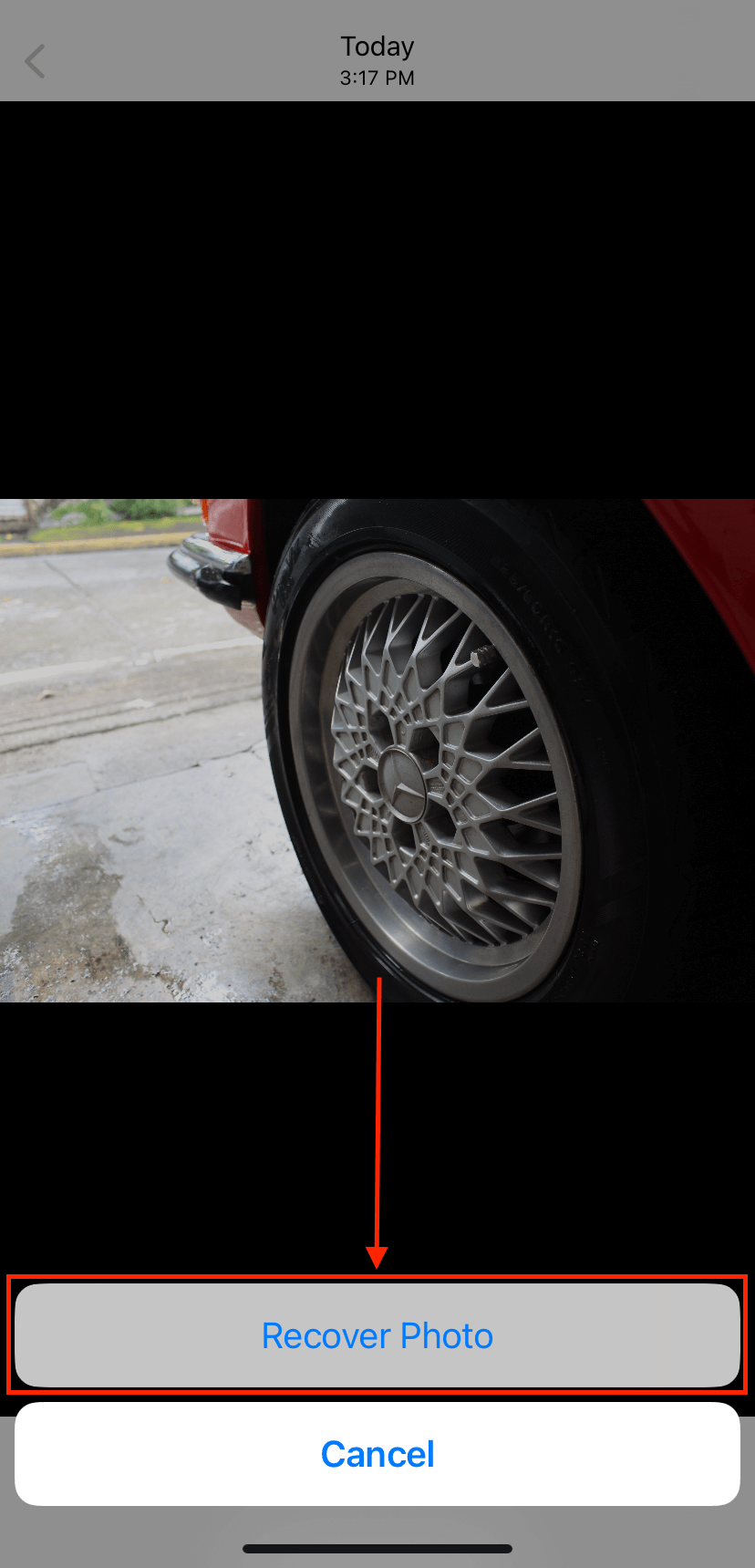
You should find your missing photos in their original albums
Method 3: Restore Photos From iCloud
If you had iCloud enabled when you deleted your photos, that change was unfortunately synced to all your iCloud-enabled devices. However, iCloud itself has a Recently Deleted folder that will store your photos for 30 days. After this period, the photos will be permanently deleted.
The cool thing about iCloud is that you can access it from any device using a browser. Check out the guide below for a demonstration.
To access deleted photos on iCloud:
- Open your browser and log into iCloud.com. Then, scroll down and click on the Photos app.
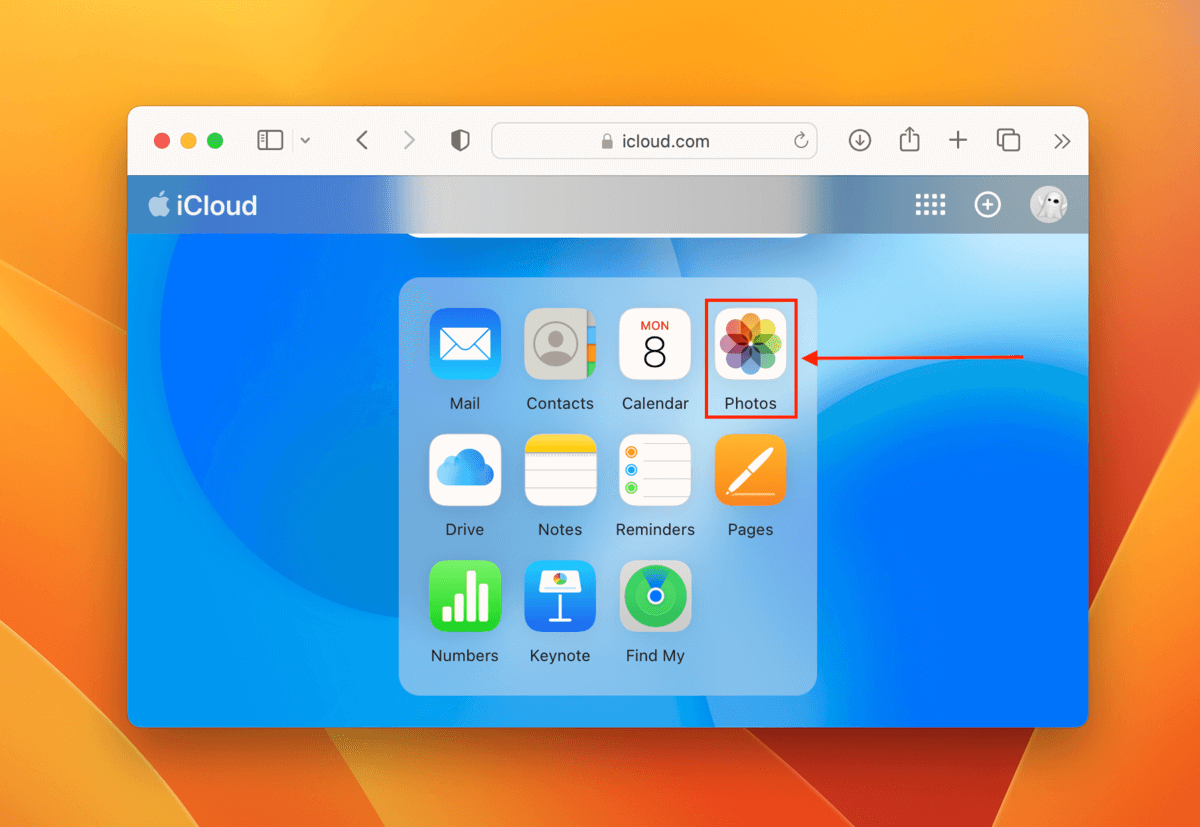
- On the left sidebar (you may have to maximize the browser window), click Recently Deleted. Then, click on any photo (or shift-click to select multiple photos) and click Recover.

You’ll find your recovered photos in their original albums.
Method 4: Restore an iTunes Backup
An iTunes backup typically copies all of the data on your iPhone, including your photos. So we can get your photos back by restoring an iTunes backup that contains the data we’re looking for.
Restoring an iTunes backup will replace all the data on your iPhone with backup data. If you currently have important files on your iPhone, save them to another location before proceeding. This method requires that you created an iTunes backup before deleting your photos.
To restore an iTunes backup on your Mac:
- Securely connect your iPhone to your Mac. Then, launch iTunes (Finder > Applications).
- Click on the iPhone icon near the top left corner of the iTunes window. Then, click Restore Backup… under the Backups section.
- Select the iTunes backup that contains the photos you want to restore. Then, click Restore.
Don’t disconnect your iPhone from your Mac until iTunes tells you it’s safe to do so. The process should take a couple of minutes. Once it’s done, check your Photos app if the data you need has been restored.
The steps for restoring photos from an iTunes backup are similar for Windows computers.
Method 5: Restore Backup With Finder
With the release of macOS Catalina (2019), Apple phased out iTunes and moved its backup and recovery tools to Finder. However, the system works pretty much the same as it did in iTunes.
By restoring a backup through Finder, we restore the data that existed on the iPhone at the time of creating the backup.
This method requires that you created a backup before deleting your photos.
- Connect your iPhone to your Mac and open Finder.
- Select your iPhone from the left sidebar and navigate to the General tab. Under the Backups section, click Restore Backup…
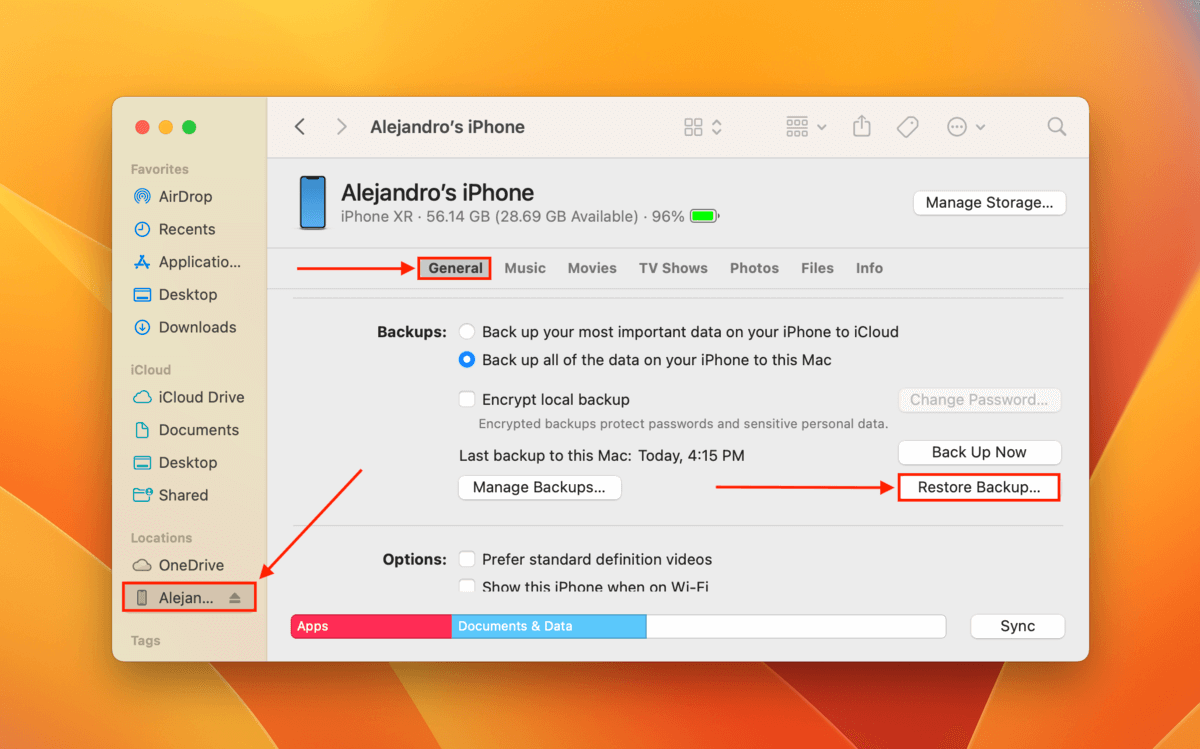
- Choose the backup that contains your photos. Then, click Restore.
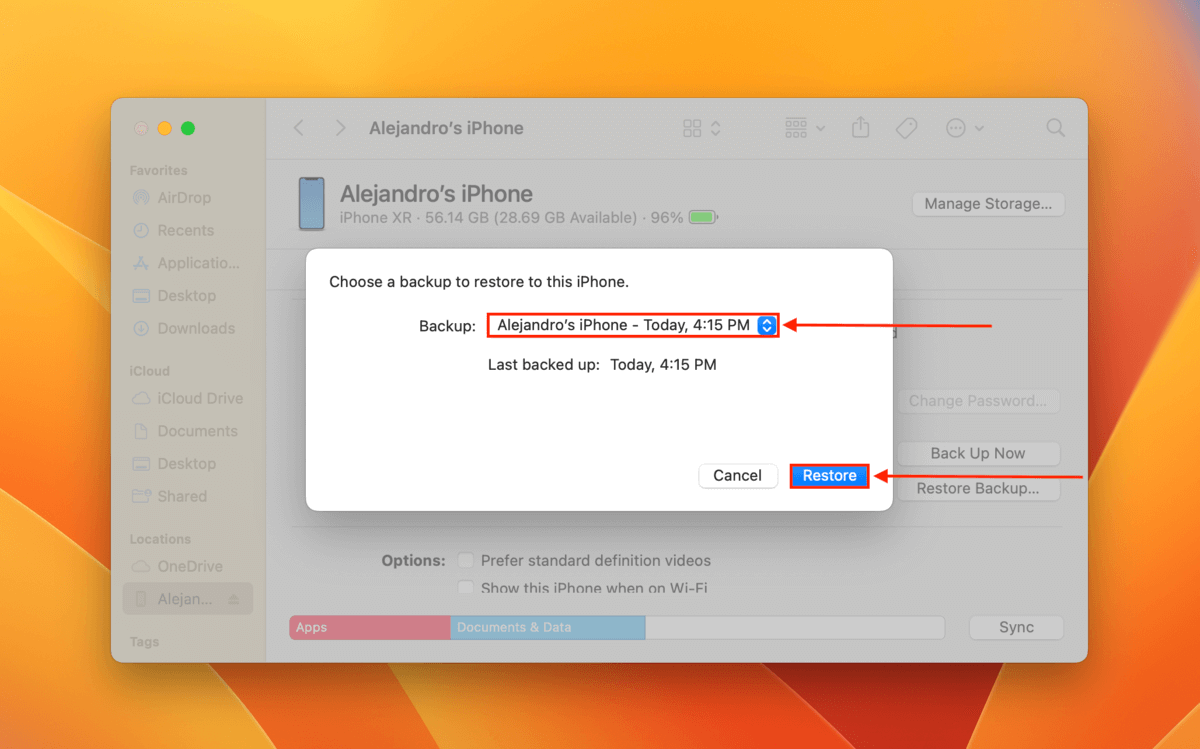
Don’t disconnect your iPhone from your Mac while your iPhone is being restored! Wait until the process is complete then if your photos have been recovered.
Method 6: Use an iPhone Data Recovery App
Let’s say you can’t find your photos in any Recently Deleted folder and you were unable to activate iCloud… How do we get our old photos back without a backup?
You can use an iPhone data recovery app to recover old deleted photos directly from your phone’s storage disk. As long as your photos haven’t been overwritten by new data (like a newly installed app or new photos/videos), you still have a chance to restore them.
Here are our top 3 iPhone data recovery software for Mac:
- Disk Drill for Mac – The Mac version of Disk Drill is optimized to restore data from iPhone devices as well as iTunes backups (without having to restore the backup). It can recover almost every single Apple file type that exists. Disk Drill is the only app out of our 3 recommendations that can restore other devices (like SD cards) as well.
- Dr. Fone by Wondershare – Dr. Fone is a data recovery app that specializes in restoring iPhones. It can restore data from your device’s file system, as well as from your iTunes and iCloud data. This includes your camera roll, messages, calendar data, and more.
- Stellar Data Recovery for iPhone – Like Dr. Fone, Stellar Data Recovery for iPhone is an iPhone-only data recovery app that can restore iPhone, iTunes, and iCloud data. It’s a great app and super well-known, but unlike the other 2, it only offers a subscription-based license.
Method 7: Check iMessage History
Did you send or receive your lost photos on iMessage? It might be worth looking through your chat history. While photos sent through iMessage are automatically stored in the Photos app, they are also saved in the conversation thread.
Even if you delete those photos from your Photos app, it doesn’t affect the copies in your conversation.
This method is not applicable to you if the photos were sent as an “expiring” message. Such media are not saved to the Photos app and only appear in the conversation for a limited time.
How to Get Deleted Photos Back on Android Phone
Depending on how you set up your Android phone, there are 5 different methods to recover deleted photos. Unlike iPhone recovery, Android recovery is (mostly) done on the device itself. We’ll walk you through each method in the sections below.
Method 1: Check Recycle Bin in Gallery
Depending on the OS version of your Android smartphone, your Gallery app should have a Recycle Bin or Recently Deleted folder that stores deleted photos for 30 days. Then, the photos are permanently deleted.
If you enabled Back up and Sync, your files will stay in the Trash folder for 60 days instead of 30.
To restore Gallery photos from the Recycle Bin/Recently Deleted folder on Android:
- Open the Gallery app. Then, tap Albums and scroll down and tap Recently Deleted.
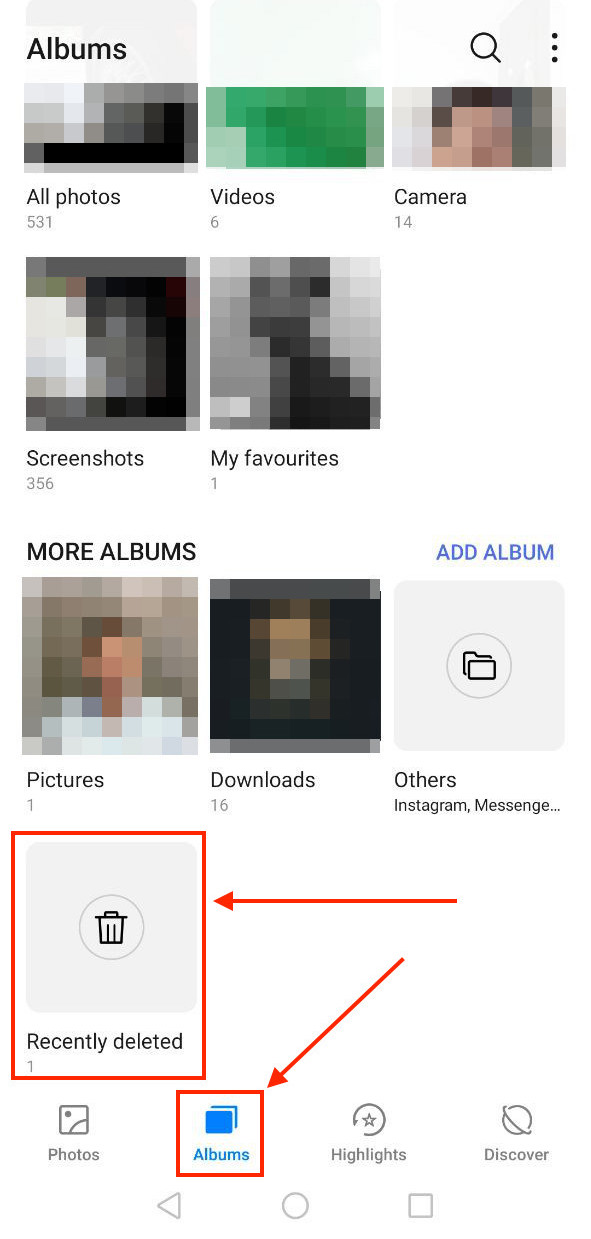
- Tap on the photo you want to recover. Then, tap Restore.

Your phone’s Gallery might look different, but the steps shouldn’t deviate much (and the Recycle Bin or Recently Deleted folder is always in the Gallery app).
Method 2: Restore From Google Photos
Did you back up your photos with Google Photos? If you deleted them from your Gallery (and from the Trash on your Android phone), Google Photos will have moved them to its own Trash folder.
You can follow this method using the Google Photos app on Android or by accessing Google Photos using a browser.
To restore deleted photos from the Google Photos Trash folder:
- Open the Google Photos app. Then, tap Library > Trash.
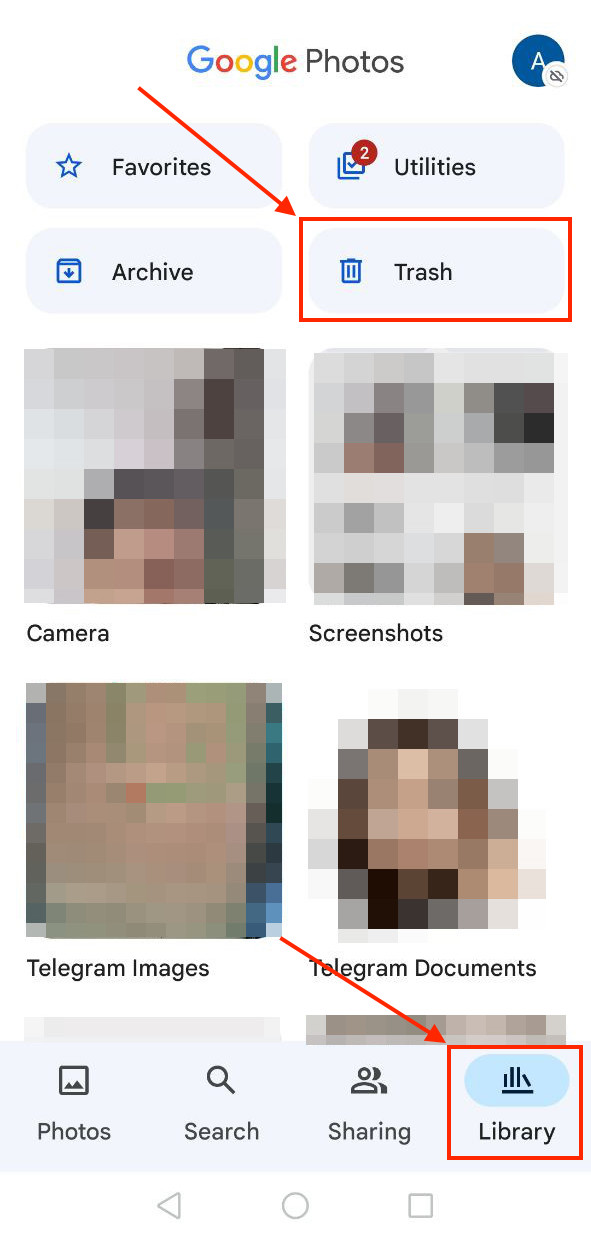
- Tap Select in the top-right corner of the screen. Then, tap the photos you want to recover and tap Restore.

You should find the restored photo in the Gallery app or Google Photos in its original album.
Data backed up by Google Photos stays in the Trash for 60 days. To recover permanently deleted photos from Google Photos after 60 days, skip to method 4.
Method 3: Restore Your Photos from Cloud Storage
Aside from Google Photos, there are other popular cloud storage services commonly used on Android devices. Some examples are Samsung Cloud, OneDrive, and Dropbox.
These mobile apps usually prompt users to enable camera upload backups – in other words, every new photo you take gets uploaded automatically to the cloud. Even if you delete these photos from your local storage, you can simply download the copy that was uploaded online.
In most cases, you can access your uploaded files in the app or by accessing its web version on your browser.
Method 4: Use an Android Data Recovery App
If you deleted your photos from the Trash folders of both your internal storage and cloud storage, you can’t access them the normal way anymore. However, their data is still on your device’s disk. The only way to access them is by using data recovery software.
Android smartphones have a wider variety of tools to choose from across different platforms. In the spirit of this article, we’ll give you our top recommendations for Mac, Android, and Windows devices.
- Disk Drill (Mac) – The Mac version of Disk Drill supports iOS and Android recovery as part of its all-in-one tool. Basically, you’ll be paying near the cost of a specialist tool (Android-only) for a full-suite data recovery software that you can use for all your devices forever. Disk Drill is highly-rated and looks great too – but you need to root your device for it to work.
- DiskDigger (Android) – If you want data recovery software that you install directly on your phone, we recommend DiskDigger. DiskDigger can restore photos and videos from your device’s internal memory or from your SD card. Even its free version and Basic Scan restored a lot of data. To use the Full Scan, you need to root your phone.
- Dr. Fone (Windows/Mac) – Dr. Fone by Wondershare is an Android-only data recovery software, but you can upgrade your license to support iOS too. Aside from general data recovery, it can recover files from broken photos and extract data from Android backups uploaded to Google Drive. As far as specialist tools go, it’s the best across the board.
Method 5: Check Your Messenger History
If you’re using one of the popular Android messengers (including the default), any media you sent or received will be saved in your conversations. So if you’re looking for photos that you originally saved from a chat, check your conversations.
In cases of apps like Facebook Messenger and Telegram (among others), you can also access a history of media sent between users for each conversation.
Conclusion
Data recovery and security have come a long way. There are tools on every platform to help users avoid total data loss. But they aren’t foolproof, so we highly recommend that you enable automatic backup in Google Photos or iCloud. And make sure that you’re using original SD cards – not knock-offs! Those are more prone to corruption and breakage.
FAQ:
- Use data recovery software like Disk Drill (Mac), DiskDigger (Android), and Dr. Fone (Windows)
- Download a copy of the deleted photos from cloud storage or backup
- Check messenger conversations for photos that you sent or received
- Restore a device backup
